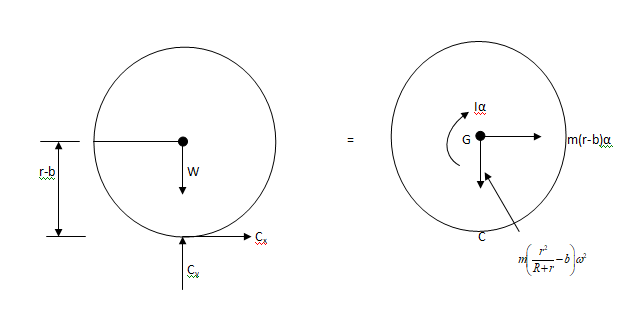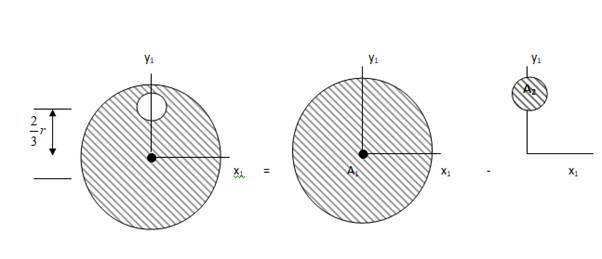
(a)
The force in the patellar tendon.
Explanation of Solution
Given information:
Cylinder weight with hole = 16 lb
Cylinder weight without hole = 15 lb
Angular velocity = 5 rad/s

Schematic of cylinder 1

Figure A
Unit
Angular acceleration of cylinder be
Let mass centre of the cylinder be G at a distance b from centre A.
Let point P coordinates with point C be
Let point G coordinates with point C be
Let point A coordinates with point C be
Point C acceleration,
Here,
Here,
Hence,
At any location on the cylinder, acceleration is
Point G acceleration,
Point A acceleration,
Substitute
Point A acceleration,
Substitute the above in equation B,
Point A velocity,
Point A acceleration vertical component,
Substitute the above in equation C,
Effective force,
Cylinder free body diagram

Figure B
Moment at point C from above figure,
From equation D, angular acceleration is zero.
Conclusion:
The cylinder angular acceleration is zero.
(b)
Components of the reaction force between the cylinder and the ground.
Explanation of Solution
Given information:
Cylinder weight with hole = 16 lb
Cylinder weight without hole = 15 lb
Angular velocity = 5 rad/s

Forces horizontal component from figure B,
Here,
Hence,
Forces vertical component from figure B,
Cylinder as combination of hole and solid is shown below

Solid cylinder area,
Solid centre of gravity in vertical direction,
Hole area,
Hole centre of gravity in vertical direction,
Equilibrium equation,
Substituting in equation E we get,
Conclusion:
The horizontal component reaction is zero and vertical reaction is
Want to see more full solutions like this?
Chapter 16 Solutions
Vector Mechanics For Engineers
- In the helicopter shown; a vertical tail propeller is used to pre- vent rotation of the cab as the speed of the main blades is changed. Assuming that the tail propeller is not operating determine the final angular velocity of the cab after the speed of the main blades has been changed from I80 to 240 rpm. (The speed of the main blades is measured relative to the cab, and the cab has a centroidal moment of inertia of 650 lb.ft.s2. Each of the four main blades is assumed to be a slender rod 14 ft weighing 55 lb.)arrow_forwardThe rotor of an electric motor has an angular velocity of 3600 rpm when the load and power are cut off. The 121-lb rotor, which has a centroidal radius of gyration of 9 in., then coasts to rest. Knowing that kinetic friction results in a couple of magnitude 2.5 lb-ft exerted on the rotor, determine the number of revolutions that the rotor executes before coming to rest. The number of revolutions that the rotor executes before coming to rest isarrow_forwardA semicircular panel with a radius r is attached with hinges to a circular plate with a radius r and initially is held in the vertical position as shown. The plate and the panel are made of the same material and have the same thickness. Knowing that the entire assembly is rotating freely with an initial angular velocity of w0 , determine the angular velocity of the assembly after the panel has been released and comes to rest against the plate.arrow_forward
- A 9-in-radius cylinder of weight 18 lb rests on a 6-lb carriage. The system is at rest when a force P of magnitude 2.5 lb is applied as shown for 1.2s. Knowing that the cylinder rolls without sliding on the carriage and neglecting the mass of the wheels of the carriage, determine the resulting velocity of (a) the carriage, (b) the center of the cylinder.arrow_forwardTwo uniform cylinders, each of mass m = 6 kg and radius r = 125 mm, are connected by a belt as shown. Knowing that at the instant shown the angular velocity of cylinder A is 30 rad/s counterclockwise, determine (a) the time required for the angular velocity of cylinder A to be reduced to 5 rad/s, (b) the tension in the portion of belt connecting the two cylinders.arrow_forwardThe 30-kg uniform disk A and the bar BC are at rest and the 5-kg uniform disk D has an initial angular velocity of w1 with a magnitude of 440 rpm when the compressed spring is released and disk D contacts disk contacts disk A. The system rotates freely about the vertical spindle BE. After a period of slippage, disk D rolls without slipping. Knowing that the magnitude of the final angular velocity of disk D is 176 rpm, determine the final angular velocities of bar BC and disk A. Neglect the mass of bar BC.arrow_forward
- The rotor of an electric motor has an angular velocity of 3600 rpm when the load and power are cut off. The 120-lb rotor, which has a centroidal radius of gyration of 9 in., then coasts to rest. Knowing that kinetic friction results in a couple of magnitude 2.5 lb·ft exerted on the rotor, determine the number of revolutions that the rotor executes before coming to rest.arrow_forwardThe 10-in.-radius brake drum is attached to a larger flywheel which is not shown. The total mass moment of inertia of the flywheel and drum is 22 lb ⋅ ft ⋅ s 2 and the coefficient of kinetic friction between the drum and the brake shoe is 0.41. Knowing that the initial angular velocity is 255 rpm clockwise, determine the force which must be exerted by the hydraulic cylinder at point B if the system is to stop in 85 revolutions. DO NOT ROUND OFF IN THE SOLUTION. ROUND OFF ONLY THE FINAL ANSWERarrow_forwardTwo disks of the same material are attached to a shaft as shown. Disk A has a radius r and a thickness 2b, while disk B has a radius nr and a thickness 2b. A couple M with a constant magnitude is applied when the system is at rest and is removed after the system has executed two revolutions. Determine the value of n that results in the largest final speed for a point on the rim of disk B.arrow_forward
- The rotor of an electric motor has an angular velocity of 3600 rpm when the load and power are cut off. The 110-lb rotor, which has a centroidal radius of gyration of 9 in., then coasts to rest. Knowing that the kinetic friction of the rotor produces a couple with a magnitude of 2.5 1b.ft determine the number of revolutions that the rotor executes before coming to rest.arrow_forwardRequired information NOTE: This is a multi-part question. Once an answer is submitted, you will be unable to return to this part. A 4-kg slender rod is welded to the edge of a 3-kg uniform disk as shown. The assembly rotates about A in a vertical plane under the combined effect of gravity and of the vertical force P. Know that at the instant shown, the assembly has an angular velocity of 12 rad/s and an angular acceleration of 36.5 rad/s2, both counterclockwise. 120 mm Determine the force P. B The force P is D 240 mm с 240 mm (You must provide an answer before moving on to the next part.) |N.↓arrow_forward4. Determine the angular acceleration of a flywheel in the form of a disc 400 mm in diameter and having a mass of 60 kg, if the applied torque is 24 Nm.arrow_forward
 Elements Of ElectromagneticsMechanical EngineeringISBN:9780190698614Author:Sadiku, Matthew N. O.Publisher:Oxford University Press
Elements Of ElectromagneticsMechanical EngineeringISBN:9780190698614Author:Sadiku, Matthew N. O.Publisher:Oxford University Press Mechanics of Materials (10th Edition)Mechanical EngineeringISBN:9780134319650Author:Russell C. HibbelerPublisher:PEARSON
Mechanics of Materials (10th Edition)Mechanical EngineeringISBN:9780134319650Author:Russell C. HibbelerPublisher:PEARSON Thermodynamics: An Engineering ApproachMechanical EngineeringISBN:9781259822674Author:Yunus A. Cengel Dr., Michael A. BolesPublisher:McGraw-Hill Education
Thermodynamics: An Engineering ApproachMechanical EngineeringISBN:9781259822674Author:Yunus A. Cengel Dr., Michael A. BolesPublisher:McGraw-Hill Education Control Systems EngineeringMechanical EngineeringISBN:9781118170519Author:Norman S. NisePublisher:WILEY
Control Systems EngineeringMechanical EngineeringISBN:9781118170519Author:Norman S. NisePublisher:WILEY Mechanics of Materials (MindTap Course List)Mechanical EngineeringISBN:9781337093347Author:Barry J. Goodno, James M. GerePublisher:Cengage Learning
Mechanics of Materials (MindTap Course List)Mechanical EngineeringISBN:9781337093347Author:Barry J. Goodno, James M. GerePublisher:Cengage Learning Engineering Mechanics: StaticsMechanical EngineeringISBN:9781118807330Author:James L. Meriam, L. G. Kraige, J. N. BoltonPublisher:WILEY
Engineering Mechanics: StaticsMechanical EngineeringISBN:9781118807330Author:James L. Meriam, L. G. Kraige, J. N. BoltonPublisher:WILEY





